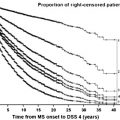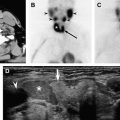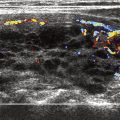Thyroid ophthalmopathy is a common autoimmune, inflammatory disease involving the orbit. Diagnosis is based on the clinical presentation and findings. Imaging, mainly CT and MR imaging, are helpful to reveal the extent of disease and degree of muscle enlargement and to evaluate for complications, such as optic nerve compression. This article reviews the basic pathology and pathophysiology of the disease and describes the extensive imaging findings on CT and MR imaging. The differential diagnosis of thyroid ophthalmopathy is reviewed.
Graves disease or thyroid ophthalmopathy (TO) is an autoimmune disease affecting the thyroid gland, orbital soft tissues, and subcutaneous tissues of the extremities. It is the most common type of hyperthyroidism, which is a state of excess circulating thyroid hormones attributable to overstimulation and oversecretion of the thyroid gland. It differs from thyrotoxicosis, which is a state of excess circulating thyroid hormones irrespective of the cause. It was in 1835 that Robert Graves described four cases of ophthalmopathy associated with thyroid disease. Although in recent years the disease has been called by Graves’s name, the first original description of the disease was made by Caleb Perry around 1825. Karl von Basedow later described the association of exophthalmos and thyrotoxicosis. This disorder thus is sometimes also referred as Parry disease or von Basedow disease. Our understanding of TO has greatly increased in the last 2 decades, but several issues regarding nomenclature, pathophysiology, and treatment are yet to be completely elucidated. Fundamentally, there is still disagreement over the correct name and it is referred to by many names, such as thyroid-associated ophthalmopathy, autoimmune thyroid disease, endocrine exophthalmos, malignant exophthalmos, dysthyroid ophthalmopathy, and thyroid eye disease. Graves disease is the most commonly used name in United States.
TO has an approximate incidence of 0.5% in United States. It is one of the common orbital disorders and is the underlying cause in 15% to 28% of unilateral exophthalmos and almost 80% of bilateral exophthalmos. Approximately 70% to 80% of patients who have TO develop hyperthyroidism within an 18-month period. A small percentage of patients have hypothyroidism or Hashimoto thyroiditis together with eye signs.
Pathology and pathophysiology
On histopathology the most prominent finding in TO is swelling of the extraocular muscles (EOMs), which can become grossly enlarged. In postmortem work, Rundle and colleagues analyzed the EOM in a man who had severe TO who died of myocardial infarction. The swollen EOM felt like rubber and had a diameter of greater than 1 cm. On microscopy the muscles showed fibrosis, edema, and lymphocytic infiltration. The swelling of the muscles was not because of an increase in the number of muscle fibers, but because of an increase in the volume of individual fibers plus an increase in connective tissue. Separately, using three-dimensional CT volume studies, van der Gaag and colleagues found swelling of EOMs alone in 20% of their patients who had TO. In 48% both EOMs and the adipose tissues were swollen, whereas in 28% the EOM volume was normal but the adipose tissue compartment had increased in volume; in 4% an increase in orbital tissue was apparent. It therefore appears that fat, muscles, and the lacrimal gland can increase considerably in volume in patients who have TO.
In the earlier descriptions it was noticed that the swelling of the EOMs and adipose tissue was attributable to an increase in what was called the “ground substance.” Now we know that this substance consists of collagen and glycosaminoglycans (GAGs), which can be found throughout the muscle fibers in the endomysial space. The most prominently present GAGs are hyaluronic acid and chondroitin sulfate. GAGs are hydrophilic and thus attract water and cause edema of the EOMs and retro-ocular tissues. Despite this accumulation of GAGs and collagen there is no evidence of damage to the muscle fibers themselves. In addition many researchers have found deposition of fibroblasts within the endomysial space and in the connective/adipose tissues, which are considered to be responsible for the overproduction of GAG. Apart from these fibroblasts, there is also a mononuclear cell infiltration, consisting of lymphocytes, macrophages, and plasma cells. The chronic stage of TO results in interstitial fibrosis with resultant muscle atrophy and fatty degeneration. Electron microscopy and electromyography have not detected a primary pathologic process in the muscle cells, confirming that the degeneration and atrophy are secondary to interstitial inflammation and fibrosis.
The fundamental cause of TO is the production of autoantibodies that bind to and stimulate the thyroid-stimulating hormone receptor (TSHR). The close clinical association between autoimmune hyperthyroidism, ophthalmopathy, and pretibial dermopathy suggests that the antigen responsible for these diverse conditions is common to the thyroid gland, orbital tissues, and pretibial skin. It is postulated that the immune complexes reach the orbit by way of the superior cervical lymph channels that drain the thyroid gland and the orbit. Although the exact cause for TO remains unknown, the disease is believed to result from a complex interplay of genetic and environmental factors. Genes, such as those for human leukocyte antigen, may determine a patient’s susceptibility to the disease and its severity, but environmental factors, often unknown, determine its course. Once established the inflammatory process within the orbital tissues seems to take on a momentum of its own. Based on this current state of knowledge it is proposed that in patients who have TO the circulating T cells, directed against certain antigens on thyroid follicular cells, recognize epitopes of antigens following processing and presentation by dendritic cells and nonprofessional antigen-presenting cells, such as orbital fibroblasts. Orbital preadipocytes and fibroblasts are stimulated by unknown circulating or locally produced factors to differentiate into mature adipocytes that express increased levels of TSHR. T cell recruitment into orbital tissues is facilitated by various cytokines and chemokines, which help to attract T cells by stimulating the expression of certain adhesion molecules (eg, ICAM-1, VAM-1, CD44). T cells and macrophages along with local fibroblasts and adipocytes are known to synthesize and release several cytokines (most likely Th-1 type spectrum) into the surrounding tissues. Cytokines, oxygen free radicals, and fibrogenic growth factors, released from infiltrating inflammatory and residential cells, act on orbital preadipocytes to stimulate adipogenesis, fibroblast proliferation, GAG synthesis, and expression of immunomodulatory molecules. Smoking, a well-known aggravating factor for TO, may enhance tissue hypoxia and exert immunomodulatory effects. The long-held hypothesis of thyroid cross-reactive or shared antigen with the orbital tissues has recently gained significant support from animal models and by in vitro and ex vivo studies.
Clinical features
Depending on the intake of iodine, TO forms 50% to 60% of hyperthyroidism in Europe and is the most common autoimmune disease in United States. Its incidence is 0.5:1000 women per year. The signs and symptoms of TO are varied and involve different systems. Symptoms of hyperthyroidism often result in changes in energy level, weight, sleep, bowel movements, heart rate, heart rhythm, skin, and hair. Family history is helpful because TO is believed to have more than 30% identifiable heredity along with other autoimmune disorders. Although it can occur over a wide age range of 15 to 86 years, it typically peaks in the fourth and fifth decades of life. Females are affected much more than males, in the ratio of 4 to 1. Social history is sometimes helpful because it is known to be aggravated by smoking, stress, dietary factors, and other extraneous factors.
The main clinical features of TO are summarized in Werner Classification, known as NOSPECS ( Table 1 )
| Class | Grade | Suggestions for Grading |
|---|---|---|
| 0 | No physical signs or symptoms | |
| 1 | Only signs | |
| 2 | Soft tissue involvement | |
| 0 | Absent | |
| a | Minimal | |
| b | Moderate | |
| c | Marked | |
| 3 | Proptosis 3 mm or more above upper normal limit | |
| 0 | Absent | |
| a | 23–24 mm | |
| b | 25–27 mm | |
| c | >28 mm | |
| 4 | EOM involvement: graded according to diplopia | |
| 0 | Absent | |
| a | Intermittent (when fatigued) | |
| b | Inconstant (at extremes of gaze) | |
| c | Constant (in primary gaze) | |
| 5 | Corneal involvement | |
| 0 | Absent | |
| a | Stippling of cornea | |
| b | Ulceration | |
| c | Clouding, necrosis, perforation | |
| 6 | Vision loss attributable to optic nerve involvement | |
| 0 | Absent | |
| a | Disc pallor, visual field defect, vision 0.63–0.5 | |
| b | Same, but vision is 0.4–0.1 | |
| c | Same, but vision <0.1–blindness |
Class I: Only Signs, No Symptoms
This class refers to upper eyelid retraction. This retraction causes stare and lid lag on downward gaze (von Graefe sign) and can be caused by swelling of the superior levator muscle. Early in the disease this lid retraction is sympathomimetic but in later stages it is attributable to fibrosis of the lid tissue.
Class II: Soft Tissue Involvement
This class entails chemosis (edema of the conjunctiva), conjunctival injection, and redness and swollen upper and lower eyelids. These findings are partly explained by impaired venous drainage because of an increase in retrobulbar tissue. Another explanation for the swelling of the eyelids is herniation of retrobulbar tissue through the naturally occurring herniations in the orbital septum.
Class III: Proptosis
Because of confining bony walls, the swollen retrobulbar tissue has no other outlet than pushing the globe forward. In postmortem studies Rundle and Pochin demonstrated that the normal orbital volume of eye muscles is 3.5 mL and the orbital cavity is 26 mL. They then showed that an increase in muscle volume of 4 mL causes a proptosis of 6 mm. Small change in tissue volume can thus cause considerable proptosis.
Class IV: Extraocular Muscle Involvement
With increasing swelling, there is impairment in the normal motility of the EOMs. Motility disturbances are also seen with thyroid ophthalmopathy. It is initially characterized by limitation of lid elevation followed by limitation in horizontal movement. These limitations are usually associated with diplopia in the corresponding visual fields. Although all muscles at some stage may be involved in the disease process, the order of involvement is inferior rectus muscles followed by medial, superior, and lateral recti.
Class V: Corneal Involvement
Exophthalmos, lid retraction, and less frequent blinking all contribute to exposure of the cornea, which can lead to keratitis. Early signs are photophobia, a gritty sensation, blurred vision, and intolerance to contact lenses. The presence of corneal irritation is not by itself a sign of severe ophthalmopathy, because it can be relieved by liberal application of eye drops and ointments.
Class VI: Vision Loss
Vision loss because of optic nerve damage can be combined with visual field defects and impaired color vision. There is no evidence of direct inflammation of the optic nerve itself and optic neuropathy is probably attributable to swelling and compression from EOMs or venous stasis close to the apex of the orbit, known as apical crowding. Another explanation is an increase in retrobulbar pressure.
Dolman and colleagues advocated VISA classification for patients who have thyroid ophthalmopathy. The VISA acronym stands for vision, inflammation, strabismus, and appearance/exposure, and deals with four common dysfunctions of TO.
Clinical features
Depending on the intake of iodine, TO forms 50% to 60% of hyperthyroidism in Europe and is the most common autoimmune disease in United States. Its incidence is 0.5:1000 women per year. The signs and symptoms of TO are varied and involve different systems. Symptoms of hyperthyroidism often result in changes in energy level, weight, sleep, bowel movements, heart rate, heart rhythm, skin, and hair. Family history is helpful because TO is believed to have more than 30% identifiable heredity along with other autoimmune disorders. Although it can occur over a wide age range of 15 to 86 years, it typically peaks in the fourth and fifth decades of life. Females are affected much more than males, in the ratio of 4 to 1. Social history is sometimes helpful because it is known to be aggravated by smoking, stress, dietary factors, and other extraneous factors.
The main clinical features of TO are summarized in Werner Classification, known as NOSPECS ( Table 1 )
| Class | Grade | Suggestions for Grading |
|---|---|---|
| 0 | No physical signs or symptoms | |
| 1 | Only signs | |
| 2 | Soft tissue involvement | |
| 0 | Absent | |
| a | Minimal | |
| b | Moderate | |
| c | Marked | |
| 3 | Proptosis 3 mm or more above upper normal limit | |
| 0 | Absent | |
| a | 23–24 mm | |
| b | 25–27 mm | |
| c | >28 mm | |
| 4 | EOM involvement: graded according to diplopia | |
| 0 | Absent | |
| a | Intermittent (when fatigued) | |
| b | Inconstant (at extremes of gaze) | |
| c | Constant (in primary gaze) | |
| 5 | Corneal involvement | |
| 0 | Absent | |
| a | Stippling of cornea | |
| b | Ulceration | |
| c | Clouding, necrosis, perforation | |
| 6 | Vision loss attributable to optic nerve involvement | |
| 0 | Absent | |
| a | Disc pallor, visual field defect, vision 0.63–0.5 | |
| b | Same, but vision is 0.4–0.1 | |
| c | Same, but vision <0.1–blindness |
Stay updated, free articles. Join our Telegram channel

Full access? Get Clinical Tree






